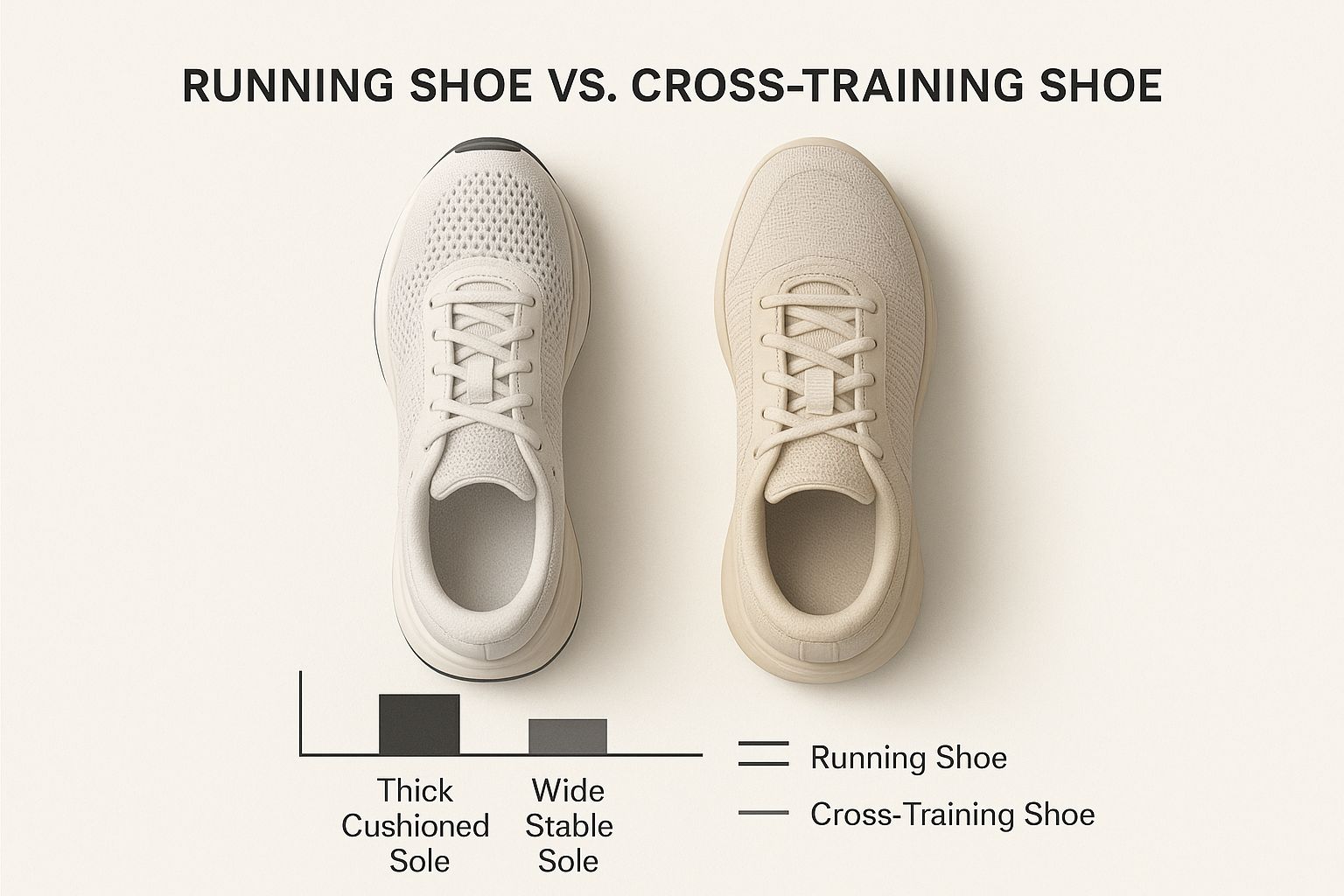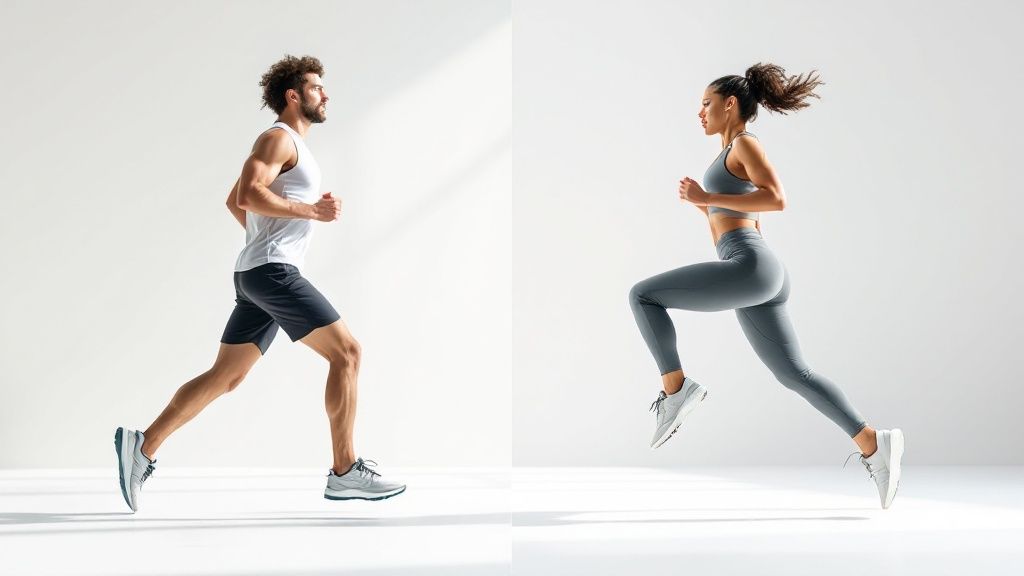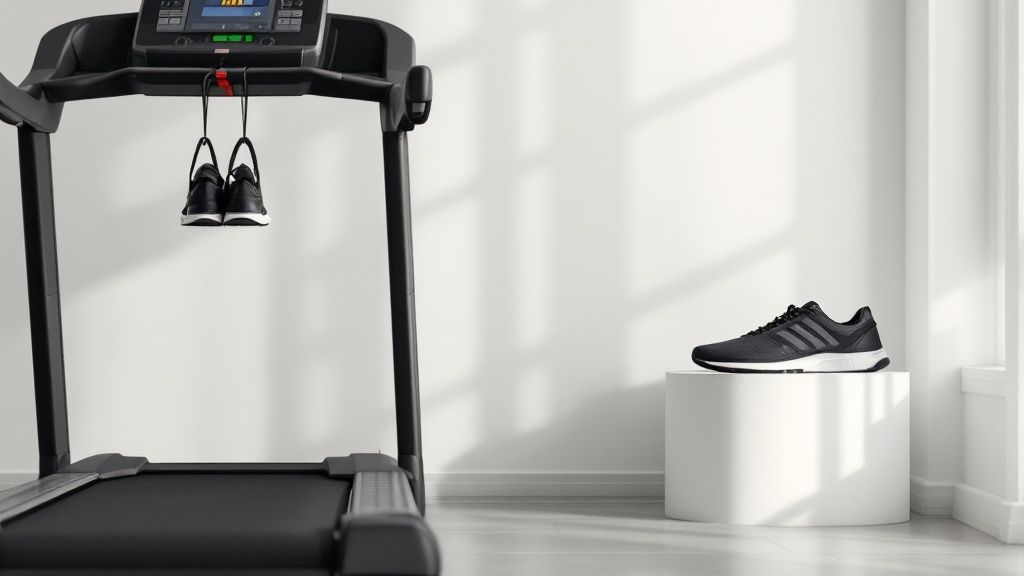Cross-Training vs Running Shoes: Explained
- Flourish Everyday Health And Fitness

- Sep 5
- 9 min read
Updated: Sep 16
At their core, the difference between a cross-trainer and a running shoe boils down to one simple thing: purpose. A running shoe is a specialist, built for one job and one job only—absorbing the impact of repetitive, forward motion, mile after mile. On the other hand, cross-trainers are the all-rounders, designed with stability in mind for the dynamic, multi-directional movements you’ll find in a gym, like lunges, lifts, and jumps.
My younger years were spent running for cardio and hours of gym work, but as I have gotten older, I am now exclusively a gym-goer. Unfortunately for me, at the beginning of my transition, the shoes didn't change, but the workout did. My feet paid the price. Today, the right shoes for the right job are essential for happy feet and an efficient workout.
Section Guide For Your Convenience:
Why Your Shoe Choice Is Your Foundation
Picking the right athletic shoe is about so much more than just color or style; it’s a critical decision for your performance and, more importantly, for preventing injuries. The shoe you lace up should be a perfect match for what you’re about to do.
Using the wrong shoe doesn't just hold you back—it can put you at risk. Trying to lift weights in a running shoe creates a mushy, unstable base. And trying to run a 10k in a pair of cross-trainers will leave your joints screaming for the shock absorption they desperately need.
This has never been more critical. The athletic shoe market is booming—valued at around USD 55.76 billion in 2023, it's expected to hit USD 88.80 billion by 2032 [1]. That growth is fueled by a global focus on getting fit, which means more people than ever need to understand what they're putting on their feet. You can get a closer look at this trend and the training shoes market growth.
The Philosophy Behind the Design
Think of a running shoe as a specialist doctor. It’s an expert in a single, focused area. Every element, from its thick, cushioned midsole to its breathable upper, is engineered to support a runner’s heel-to-toe gait over long distances. A cross-trainer is more like your family doctor—a general practitioner with a broad knowledge base, built to provide a stable platform for a wide variety of activities.
If you remember one thing, make it this: Running shoes are for moving in a straight line. Cross-trainers are for moving in every direction. That single concept dictates every single difference in how they’re built.
A Quick Side-by-Side
Feature Focus | Running Shoes | Cross-Training Shoes |
|---|---|---|
Primary Goal | Shock absorption for forward motion | Stability for varied movements |
Midsole Cushion | Soft and thick to soften impact | Firm and dense for a stable base |
Flexibility | Flexible in the forefoot for toe-off | Generally stiffer for support |
Ideal Activities | Road running, treadmill, marathons | HIIT, weightlifting, fitness classes |
Comparing the Anatomy of Athletic Shoes
To settle the "cross training vs running shoes" debate, you have to look past their names and get into how they're actually built. The materials, the shape, and all the tech packed inside are engineered for completely different movements.

You can immediately see the runner's plush, cushioned heel against the cross trainer's wide, stable base. It's a perfect visual of their specialized designs.
Anatomy Breakdown Cross Training vs Running Shoes
Feature | Running Shoes (Designed for Forward Motion) | Cross Training Shoes (Designed for Versatility) |
|---|---|---|
Midsole | Thick, soft, and highly cushioned to absorb repetitive impact from running. Think plush and bouncy. | Firmer, denser, and more stable to provide a solid platform for lifting and lateral movements. |
Outsole | Flexible with grooves designed for smooth heel-to-toe transitions and forward traction. | Durable with multi-directional grip patterns. Often wraps up the sides for rope climbs and side-to-side stability. |
Upper | Made of lightweight, breathable mesh to maximize airflow and keep feet cool over long distances. | More robust and reinforced to lock the foot in place during lateral movements and quick cuts. |
Heel-to-Toe Drop | Higher drop (8-12mm+) to promote a forward rolling motion and reduce Achilles strain. | Lower drop (0-6mm) to keep you closer to the ground for better balance and stability during lifts. |
The Midsole Cushioning vs Stability
The midsole is the heart of the shoe and where you'll find the biggest divide. In a running shoe, the midsole is all about soft, thick cushioning to absorb the shock of your foot hitting the ground—a force that can be 2 to 3 times your body weight with every step [2].
A cross-training shoe has a much firmer, denser midsole, giving you a stable platform connected to the floor. Ever tried doing a heavy squat in running shoes? It feels like lifting on a mattress. The soft foam compresses unevenly, creating an unsafe base. A cross trainer’s firmness is non-negotiable for stability.
The Outsole Grip vs Durability
A running shoe's outsole is built for forward motion, with grooves for a smooth ride. A cross-training shoe’s outsole is designed for multi-directional grip and durability. The rubber is often harder and might wrap up the sides for extra grip during side shuffles and protection during rope climbs.
A running shoe is built to flex forward, while a cross trainer is engineered to grip in every direction and withstand diverse forms of wear and tear.
The Upper Support vs Breathability
For runners, breathable, lightweight uppers are key to keep feet cool. Cross-training shoes need a more robust and supportive upper. While still breathable, the materials are tougher with extra reinforcement to lock your foot down during lateral movements.
Understanding Heel-to-Toe Drop
Heel-to-toe drop is the height difference between your heel and forefoot.
Running Shoes: A higher drop (8-12mm+) encourages a forward rolling motion and can reduce Achilles tendon strain.
Cross Training Shoes: A lower drop (0-6mm) brings your foot closer to the ground for a more stable and balanced foundation for lifting.
Every feature is there for a reason. Choosing between cross training vs running shoes is a critical decision for performance and staying injury-free.
Why Runners Need Specialized Footwear
Running is a uniquely demanding, high-impact, repetitive motion. Each time your foot hits the ground, it absorbs a force of two to three times your body weight [2]. That impact travels up through your joints, which is why specialized running shoes are essential equipment.

Unlike cross trainers, running shoes are meticulously engineered to manage the relentless impact of forward motion through specific design features.
Engineered for the Repetitive Impact
The heart of a running shoe is its heavily cushioned midsole. This foam layer compresses and rebounds, absorbing shock that would otherwise jolt your legs. Without this cushioning, runners are more likely to suffer from overuse injuries. Running shoes also typically feature a significant heel-to-toe drop (8mm or more) to promote a smooth, forward-rolling motion.
The core function of a running shoe is to provide a protective buffer between your body and the hard pavement. A cross trainer cannot offer the same level of shock absorption.
The Health Risks of Using the Wrong Shoe
Running regularly in cross trainers can lead to pain and injury. Their design lacks the specific support needed for constant, linear motion, which can lead to common conditions:
Shin Splints: Pain caused by repetitive stress on the shinbone, often worsened by footwear lacking proper shock absorption.
Plantar Fasciitis: The firm sole of a cross trainer doesn’t support the arch's natural movement during a run, leading to inflammation and heel pain.
Stress Fractures: Without enough cushioning, the small bones in your feet are subjected to excessive force, increasing the risk of tiny cracks.
The cross training vs running shoes debate is clear when you consider your goals. Training for a 5K or marathon requires dedicated running shoes to handle the cumulative impact and stay healthy. If you mix activities, our guide on finding the best CrossFit running shoes can help find a hybrid model.
When to Choose a Cross Training Shoe
While a running shoe is a specialist, the cross-training shoe is the ultimate utility player. It's the multi-tool of athletic footwear, engineered for dynamic, varied workouts where versatility is everything. If your fitness routine is more than just running, a cross-trainer is your best bet.

These shoes are perfect for HIIT, CrossFit, or any group fitness setting. Their design balances a stable base, durable outsole, and reinforced uppers to support a workout that changes on a dime.
The Foundation for Strength and Agility
A cross-training shoe's standout feature is its firm, low-profile midsole. This creates a stable platform essential for weightlifting like squats and deadlifts. Unlike the soft foam in a running shoe, a cross-trainer's solid base minimizes energy loss and keeps your foot locked to the ground. This stability is also crucial for agility drills, box jumps, and lateral lunges, where the shoe’s structure prevents your foot from sliding.
A cross-trainer’s primary mission is to provide a balanced foundation for multi-directional force, sacrificing plush cushioning for unwavering stability.
Ideal Workouts for Cross-Trainers
A cross-trainer is the winner for any workout that mixes different types of movement.
HIIT and Circuit Training: Ideal for rapid transitions between exercises like burpees and kettlebell swings.
Weightlifting and Powerlifting: The flat, firm sole is critical for safety and performance, letting you drive force through the ground effectively.
Group Fitness Classes: The lateral support protects your ankles and provides a responsive feel during multi-directional movements.
If your routine is diverse, a specialized shoe is a game-changer. For more, see our guide on the best running shoes for cross training.
Choosing the Right Shoe for Your Workout
Figuring out the right shoe boils down to your personal fitness routine. Let’s dive into common fitness profiles to see which shoe fits your goals.
The Dedicated Runner Who Lifts Twice a Week
If your main focus is logging miles, you need dedicated running shoes. The high-impact nature of running demands specific cushioning that only a running shoe provides. Trying to run miles in a cross-trainer risks injuries like shin splints. While lifting in running shoes isn't ideal, it's a workable compromise for lighter strength work. However, owning a pair of each is the smartest investment for serious athletes.
The CrossFit and HIIT Enthusiast
For workouts mixing weightlifting, gymnastics, and metabolic conditioning, a cross-training shoe is non-negotiable. These shoes are built to handle the wild variety of movements in CrossFit and HIIT. You need a stable base for lifts, tough outsoles for rope climbs, and reinforced uppers for lateral movements. A running shoe would be dangerously unstable during a heavy lift.
For the dynamic, multi-directional athlete, the cross trainer is the definitive choice. Its versatility and stability are paramount.
Check out our guide to the top 3 ranked women's cross-training shoes of 2025 for models built for this training style.
The Casual Gym-Goer
If your gym session includes a bit of everything—cardio machines, weight circuits, and fitness classes—a cross-training shoe is the most practical and versatile option. It strikes the perfect balance of support and flexibility for someone who does it all. The firm sole provides stability for strength equipment, while the reinforced upper supports quick movements in classes.
Common Questions About Athletic Footwear
The cross training vs running shoes debate often comes down to your unique routine. Here are answers to the most common questions.
Can I Use Running Shoes for Weightlifting?
It is strongly advised against. The soft cushion in a running shoe creates an unstable foundation for heavy lifts like squats, increasing your risk of injury and compromising form. The elevated heel in many running shoes can also disrupt your lifting mechanics. A firm, flat cross trainer is necessary for safe, effective lifting.
Is It Safe to Run Short Distances in Cross Trainers?
For a quick warm-up on the treadmill (5-10 minutes), you'll be fine. However, they should never be your go-to for regular or long-distance running. Cross trainers lack the specialized cushioning to absorb sustained impact, increasing your risk for injuries like shin splints or stress fractures.
A cross trainer can handle a short run far better than a running shoe can handle a heavy lift. If versatility is key, the cross trainer has the edge in a gym environment.
How Often Should I Replace My Athletic Shoes?
This depends on the shoe type and usage.
Running Shoes: Replace every 300-500 miles. After this point, the midsole foam breaks down and loses its ability to absorb shock effectively [3].
Cross Training Shoes: Look for physical signs of wear. A compressed midsole, worn-down tread, or tears in the upper are signs you need a new pair. For workouts 3-4 times a week, expect to replace them every 8-12 months.
If I Can Only Buy One Pair, Which Should It Be?
Your primary activity dictates your choice. If you’re a runner, you must buy running shoes. The protective features are non-negotiable for preventing injury. If you spend most of your time in the gym doing HIIT, classes, or lifting, a cross trainer is the smarter, more versatile pick.
Check out more of our top shoe guides, product savings, health, and wellness tips over at https://www.flourish-everyday.com. Thank you.
At Flourish-Everyday, we're dedicated to helping you find the perfect athletic footwear to support your unique fitness journey. Explore our expert reviews and wellness guides to find everything you need to feel inspired, supported, and empowered. Visit us at https://www.flourish-everyday.com to get started.
References
[1] Global Market Insights. (2024). Training Shoes Market Size - By Product, By Distribution Channel & Forecast, 2024 – 2032. Retrieved from gminsights.com[2] Lieberman, D. E., et al. (2010). Foot strike patterns and collision forces in habitually barefoot versus shod runners. Nature, 463(7280), 531-535.[3] American Academy of Podiatric Sports Medicine (AAPSM). (n.d.). Proper Shoe Selection for the Athlete. Retrieved from aapsm.org


Comments